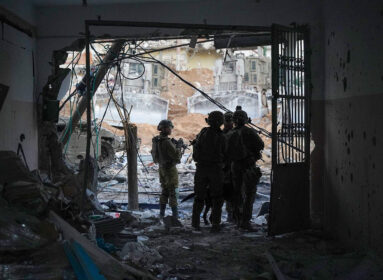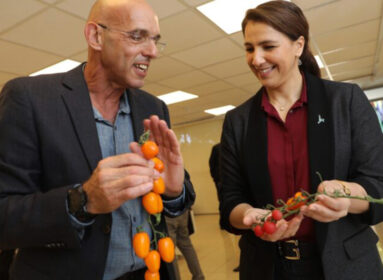
Author of The Ruined House talks about American Jewry and the crisis of faith
By Judie Jacobson
 In 2015, not long after his novel The Ruined House won Israel’s esteemed literary award, the Sapir Prize, author Ruby Namdar said in an interview with JTA that one of his greatest joys is to sit in a coffee shop in New York, hearing the buzz of English all around him, while writing in Hebrew on his laptop.
In 2015, not long after his novel The Ruined House won Israel’s esteemed literary award, the Sapir Prize, author Ruby Namdar said in an interview with JTA that one of his greatest joys is to sit in a coffee shop in New York, hearing the buzz of English all around him, while writing in Hebrew on his laptop.
Indeed, Namdar is a man deeply connected to two countries. Born and raised in Jerusalem to a family of Iranian-Jewish heritage, he moved to the United States after completing his army service, where he discovered Jewish-American writers like Saul Bellow, Philip Roth and Cynthia Ozick. Namdar’s first book, Haviv (2000), won the Israel Ministry of Culture’s Award for Best First Publication.
Namdar will deliver the Samuel and Dorothy Frankel Memorial Lecture at Wesleyan University on Thursday, April 12, at 8 p.m. Titled “The Holy Temple in Jerusalem: A Symbol of Gruesome Glory,” the lecture is free and open to the public.
In The Ruined House, which has been translated from the original Hebrew by Hilel Halkin and published by HarperCollins, Namdar tells the story of Andrew Cohen, a professor at NYU whose happy, meticulously arranged world begins to mysteriously unravel, disrupted by visions of an ancient religious ritual. The narrative is occasionally interrupted by a second plot, which is told on pages arranged to resemble the ancient Talmudic style. These faux-Talmudic pages are unprecedented in American literature, and they deepen Andrew’s connection to the past, calling into question everything he believes about his comfortable life.
When the book was published in Israel, Tablet Magazine gave it a rave review, noting its multiple layers. “It’s about American Jewry’s search for meaning. It’s about faith in modern times….It’s hard to think of [a novel] more ambitious, more engaged with the core questions that have bedeviled Jews, in Israel and abroad, for so long.”
He currently lives in New York City with his wife and two daughters and teaches Jewish literature, focusing on Biblical and Talmudic narrative.
Recently, the Ledger interviewed Ruby Namdar about The Ruined House, his view on American Jewry, and his upcoming lecture.
JEWISH LEDGER (JL): You write about religion. Were you brought up with a religious background?
RUBY NAMDAR (RN): I was born in Jerusalem to parents of Iranian-Jewish heritage. In spite of the fact that we were not really religious, the atmosphere at home was of warm Jewish tradition. I never studied in a religious school or yeshiva, but nonetheless, I found myself being drawn, at a very early age, to the wonderful world of Biblical and Talmudic text. This attraction informs and feeds my writing today. I find ancient Jewish text a wonderful source of inspiration.
JL: What was the impetus for writing The Ruined House? Where did the idea come from?
RN: In 2000, I arrived in New York City, following the rekindling of an old love story (luckily it has a happy ending: we live happily in NYC together, and raise our two daughters). It was during the first months of my stay in New York, where the idea of The Ruined House began to ferment inside me. I believe it was my way of processing this wonderful cultural shock; and the great discovery of American Jewry and American Jewish literature – about which we know very little in Israel. A great lover of the urban condition, I was especially taken by the vastness and intensity of New York City. Some say the city is so alive in my novel that it has almost become one of the protagonists.
JL: The book seems to be about American Jewry in particular – specifically, its failings. Is that accurate?
RN: The novel is certainly about American Jewry, but it is by no means a criticism of it. If anything, this novel might have been my way of discovering and identifying with the rich world of American Jewry. True, there is a satirical and critical element in the novel – but it is not limited to diaspora Jewry. Israel and Israelis are described in an even more biting, more satirical manner, as are academia and the New York City cultural elite. As a matter of fact, over the last few years, I’ve gotten into some serious trouble in Israel publicly arguing that one can lead a very meaningful Jewish life outside of Israel, and that Zionism is by no means the only way in which one can express an authentic Jewish identity.
JL: Do you think American Jews have issues related to faith that are different or more complex than other Jews, both in the diaspora and in Israel?
RN: Jews and gentiles, Israeli and Americans, we all have issues with faith nowadays – and that includes the Ultra-Orthodox and Hassidic communities. Whether we want it or not, we all live in a secular world and function within a secular culture. It takes an extra effort to maintain a religious identity in a world that is no longer governed by religious thinking. I like to point out to Israelis that they too, like American Jews, have a crisis of identity. Once the faith factor was removed from the equation, and is no longer a common denominator, we are left grappling for new modes of identification and solidarity. The Ruined House speaks of this crisis. It opens these questions and does not rush to offer answers – as there are no good ones, really.
JL: Tablet Magazine calls the book “the quintessential Hebrew novel.” What do you think makes it so?
RN: The Hebrew edition of the novel celebrated the Hebrew language with all its historic glory. It wove together modern, Biblical and medieval Hebrew in a way that was unprecedented in modern Israeli literature. The English edition, translated by the great Hillel Halkin, preserves this tension in English, which to me, is a testament to the alchemy of art, and Halkin’s mastery. A testimony to this success is the fact that Adam Kirsch [Tablet Magazine, Nov. 15, 2017] refers to the English edition of The Ruined House as “A new kind of Jewish novel, which everyone interested in Jewish literature should read” and that The New York Times [Jan. 14, 2018] called the novel “a masterpiece of modern religious literature.” It makes me very happy to see that that the power of the novel transcended the Hebrew and traveled into the English.
JL: Your Wesleyan talk is entitled “The Holy Temple in Jerusalem: A Symbol of Gruesome Glory.” Can you give us a preview?
RN: The Holy Temple in Jerusalem is one of the most fascinating symbols of our culture. It is at the same time alien, a little frightening, intriguing and some would say even slightly dangerous. For many centuries, the mourning for the loss of the temple was a major element in our religious culture. As a matter of fact, every prayer in our Siddur or Machzor is a direct reference to sacrificial or ritual practice in the Lost Temple. In my talk, I will attempt to revive some of this awe-inspiring experience, the mystery and the allure that the temple held for our ancestors – and explain why I find it to be such a potent cultural symbol to this day.
“The Holy Temple in Jerusalem: A Symbol of Gruesome Glory,” with guest lecturer Ruby Namdar, author of The Ruined House; Thursday, April 12, 8 p.m.; Wesleyan University, Russell House, 350 High St. Free and open to the public. For information: Wesleyan.edu/cjs.







 Southern New England Jewish Ledger
Southern New England Jewish Ledger















